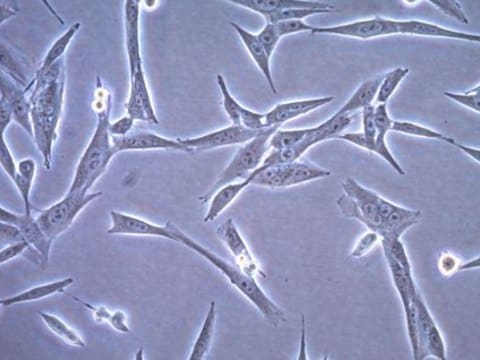SCC194
CT-2A Mouse Glioma Cell Line
Mouse
Synonym(s):
CT2A
Sign Into View Organizational & Contract Pricing
All Photos(1)
About This Item
UNSPSC Code:
41106514
eCl@ss:
32011203
NACRES:
NA.81
Recommended Products
product name
CT-2A Mouse Glioma Cell Line, CT-2A mouse glioma cell line is a valuable mouse model for therapeutic research on brain malignancies.
biological source
mouse
technique(s)
cell culture | mammalian: suitable
shipped in
ambient
General description
Glioblastomas are among the most aggressive forms of cancer, associated with low treatment efficacy and poor survival. Recurring glioblastomas are often resistant to first-line chemotherapies (1). There is much interest in studying drug-resistant forms of glioblastomas in the effort to develop effective therapies.
References:
1. Weller M, Cloughesy T, Perry JR, and Wick W (2013). Neuro Oncol 15(1): 4-27.
2. Seyfried TN, el-Abbadi M, and Roy ML (1992). Mol Chem Neuropathol 17(2):147-167.
3. Seyfried TN, Mukherjee P (2010). J Oncol 2010:961243 doi.10.1155/2010/961243.
4. Cotterchio M, Seyfried TN (1994). J Lipid Res 35(1): 10-14.
5. Binello E, Qadeer ZA, Kothari HP, Emdad L, Germano IM (2012). J Cancer 3: 166-174.
6. Martinez-Murillo R, Martinez A (2007). Histol Histopathol 22(12): 1309-1326.
7. Zimmerman HM and Arnold H. (1941). Cancer Res 1(12): 919-938.
References:
1. Weller M, Cloughesy T, Perry JR, and Wick W (2013). Neuro Oncol 15(1): 4-27.
2. Seyfried TN, el-Abbadi M, and Roy ML (1992). Mol Chem Neuropathol 17(2):147-167.
3. Seyfried TN, Mukherjee P (2010). J Oncol 2010:961243 doi.10.1155/2010/961243.
4. Cotterchio M, Seyfried TN (1994). J Lipid Res 35(1): 10-14.
5. Binello E, Qadeer ZA, Kothari HP, Emdad L, Germano IM (2012). J Cancer 3: 166-174.
6. Martinez-Murillo R, Martinez A (2007). Histol Histopathol 22(12): 1309-1326.
7. Zimmerman HM and Arnold H. (1941). Cancer Res 1(12): 919-938.
The CT-2A cell line is derived from a sub-cutaneous, non-metastatic murine glioma (astrocytoma). The originating tumor was classified as poorly differentiated with high vascularity and malignancy (2). CT-2A cells are marked by high levels of complex gangliosides and low distribution of the anti-angiogenic ganglioside GM3, as well as deficiency in the tumor suppressor PTEN/TSC2, a characteristic present in up to 70% of human high-grade glioma cell lines (3,4). CT-2A tumors are wild-type for p53 and recapitulate several features of human high-grade glioma, including high mitotic index and cell density, nuclear polymorphism, hemorrhage, pseudopalisading necrosis, and microvascular proliferation (5,6).
Source:
CT-2A was generated from a malignant astrocytoma formed via implantation of the carcinogen 20-methylcholanthrene in the cerebrum of a C57BL/6J mouse (7). The tumor was maintained through serial intracranial transplants prior to cell line isolation.
Source:
CT-2A was generated from a malignant astrocytoma formed via implantation of the carcinogen 20-methylcholanthrene in the cerebrum of a C57BL/6J mouse (7). The tumor was maintained through serial intracranial transplants prior to cell line isolation.
Cell Line Description
Cancer Cells
Application
Research Category
Cancer
Oncology
Cancer
Oncology
This product is intended for sale and sold solely to academic institutions for internal academic research use per the terms of the “Academic Use Agreement” as detailed in the product documentation. For information regarding any other use, please contact licensing@emdmillipore.com.
Quality
• Each vial contains ≥ 1X10⁶ viable cells.
• Cells are tested negative for infectious diseases by a Mouse Essential CLEAR panel by Charles River Animal Diagnostic Services.
• Cells are verified to be of mouse origin and negative for inter-species contamination from rat, chinese hamster, Golden Syrian hamster, human and non-human primate (NHP) as assessed by a Contamination CLEAR panel by Charles River Animal Diagnostic Services.
• Cells are negative for mycoplasma contamination
• Cells are tested negative for infectious diseases by a Mouse Essential CLEAR panel by Charles River Animal Diagnostic Services.
• Cells are verified to be of mouse origin and negative for inter-species contamination from rat, chinese hamster, Golden Syrian hamster, human and non-human primate (NHP) as assessed by a Contamination CLEAR panel by Charles River Animal Diagnostic Services.
• Cells are negative for mycoplasma contamination
Storage and Stability
Store in liquid nitrogen. The cells can be cultured for at least 10 passages after initial thawing without significantly affecting the cell marker expression and functionality.
Disclaimer
Unless otherwise stated in our catalog or other company documentation accompanying the product(s), our products are intended for research use only and are not to be used for any other purpose, which includes but is not limited to, unauthorized commercial uses, in vitro diagnostic uses, ex vivo or in vivo therapeutic uses or any type of consumption or application to humans or animals.
Storage Class Code
12 - Non Combustible Liquids
WGK
WGK 2
Flash Point(F)
does not flash
Flash Point(C)
does not flash
Certificates of Analysis (COA)
Search for Certificates of Analysis (COA) by entering the products Lot/Batch Number. Lot and Batch Numbers can be found on a product’s label following the words ‘Lot’ or ‘Batch’.
Already Own This Product?
Find documentation for the products that you have recently purchased in the Document Library.
T N Seyfried et al.
Molecular and chemical neuropathology, 17(2), 147-167 (1992-10-01)
The ganglioside composition of seven experimental brain tumors was examined in C57BL/6J mice. The tumors were produced from 20-methylcholanthrene (20-MC) implantation into either the cerebrum or cerebellum and were maintained in serial transplants through many generations. The tumors studied were
David Hou et al.
STAR protocols, 4(2), 102219-102219 (2023-04-21)
A B-cell-based cellular vaccine (BVax), produced from 4-1BBL+ B cells, can select tumor-specific B cells that, upon ex vivo culture, can generate tumor-specific antibodies and activate T cells. Here, we present a protocol to generate a B-cell-based vaccine in a CT2A orthotopic
Evelina Blomberg et al.
Neuro-oncology advances, 4(1), vdac148-vdac148 (2022-10-11)
Glioblastoma is the most common brain tumor in adults and virtually incurable. Therefore, new therapeutic strategies are urgently needed. Immune checkpoint inhibition has not shown activity in various phase III trials and intra- as well as intertumoral expression of programmed
R Martínez-Murillo et al.
Histology and histopathology, 22(12), 1309-1326 (2007-08-21)
Animal models of glial-derived neoplasms are needed to study the biological mechanisms of glioma tumorigenesis and those that sustain the disease state. With the aim to develop and characterize a suitable in vivo experimental mouse model for infiltrating astrocytoma, with
Hyung-Seok Kim et al.
Cancer research, 80(9), 1833-1845 (2020-02-26)
T-cell immunoglobulin and mucin domain-containing molecule 3 (TIM-3), a potential immunotherapeutic target for cancer, has been shown to display diverse characteristics in a context-dependent manner. Thus, it would be useful to delineate the precise functional features of TIM-3 in a
Our team of scientists has experience in all areas of research including Life Science, Material Science, Chemical Synthesis, Chromatography, Analytical and many others.
Contact Technical Service





